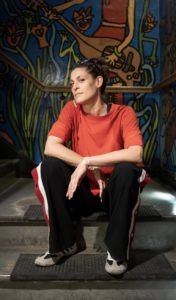#74: Wednesday, November 17, 2021
“Controlled Burn” by Dessa and Jocelyn Hagen
SSA, string quartet, piano
This work is part of the Graphite Publishing Collaboration project – involving cooperative artistic endeavors from Dessa and Jocelyn Hagen. Dessa is a singer, rapper, and hip-hop artist; Jocelyn is a composer, theorist, and performer. Together, they created this piece titled “Controlled Burn.” I am mesmerized by it!


The original work was commissioned for SATB choir and orchestra, for a massed music festival in Minneapolis Public Schools, 2014. For that voicing, accompaniment parts are available for full orchestra or mixed chamber ensemble. In 2021, the SSA arrangement was commissioned by The Women’s Chorus of Dallas (Melisa Imthurn, conductor) and Flower Mound High School Treble Choir (Mark Rohwer, conductor). The SSA version is accompanied by string quartet and piano. I’m not always a fan of SATB music re-scored for treble voices, but this arrangement was clearly done with care and attention to the usual challenges in texture, timbre, and tessitura.
Clocking in at 6 minutes, this is not a short piece, not something to add to your concert rep for a ‘last minute learn.’ But, its important to note that the choir does not sing the full 6 minutes; there is significant introduction and interlude material for the instrumental ensemble. So, it won’t take as long to learn as it first appears.
The text by Dessa is invigorating and engaging. I really *really* want to dig into the text with my singers. For copyright reasons, I won’t include the whole text in this blog, but I encourage you to read it here: https://graphitepublishing.com/product/controlled-burn-ssa-choral-score/ (scroll down to “Text”)
I often see a flagship collaboration or commission like this and realize immediately that its too difficult for my once- or twice-a-week ensembles. So often the really cool stuff is too complex and takes more rehearsal time than I have, while the accessible stuff is too young/cheesy or easy/boring (or slow…). But I am happy to report the vocal lines are singable, accessible, and within reach for a range of ensembles.
Much of the vocal writing is homophonic, with three-part harmony. Some unison phrases as well, that then break out into SSA harmony at the end. There is one 12-bar section near the end that is not homphonic. However, in that section each voice part shares one line of text, then holds an extended note while another voice part jumps in, etc. So, not complicated multi-part polyphony, so much as a gentle layering of musical/textual ideas, introduced one at a time.
There is plenty of syncopation and rhythmic interest in the voice lines, and many added accents, which supports the inherent rhythmicity in Dessa’s text. Given the frequent homophony, most of the rhythms happen across the choir, together. Personally, I’m looking forward to learning/reading the rhythms as a group, and then speaking the text in rhythm. Its an exercise we as directors do so often with our choirs, but not always with full intention. With a text that is so rhythmically-structured to start with, I really want to draw my singers’ attention to it, before we add pitches.
Tonal structure is not necessarily one for easy solfege. There are a number of accidentals, as well as triadic tonal centers in the voice parts that don’t always line up with the diatonic key signatures. I love the end result of the sound, and the 3-part triadic vocal parts make it reasonable to grab on to by ear, after some rehearsal. But, know that you can’t likely jump in on solfege easily with an ensemble.
The string and piano accompaniment adds harmonic structure in places where the voice are more rhythmic, and adds rhythmic intensity where the voices are more melodic. And the accompaniment adds tonal intricacy throughout. The instrumental-only intro and interludes run the gamut from driving and accented to smooth and lyrical. While the SATB piece is set for full orchestra or mixed chamber ensemble, the SSA version is for string quartet and piano – which makes it more accessible from a financial/space/logistics point of view, and also from a numbers/balance point as well.
We won’t start spring 2022 music until second semester begins, but I plan on having this in their folders from Day 1 of spring term. Happy Programming!
| Title: | Controlled Burn |
| Composer: | Dessa; Jocelyn Hagen https://graphitepublishing.com/composer/dessa/ https://graphitepublishing.com/composer/jocelyn-hagen/ |
| Date of Composition: | 2021 |
| Author: | Dessa |
| Language: | English |
| Listed Voicing: | SSA |
| Ranges: | S1: B3-G/A5 S2: B3-D5 A: G3-B4 |
| Accompaniment: | String quartet and piano |
| Duration: | 6:00 |
| Publisher: | Graphite Publishing
https://graphitepublishing.com/ https://graphitepublishing.com/product/controlled-burn-ssa-choral-score/ |
Until next month!
-Shelbie Wahl-Fouts
Dr. Shelbie Wahl-Fouts is Director of Choral Activities and associate professor of music at Hollins University, a women’s college in Roanoke, Virginia.
Email:
Bio: https://www.hollins.edu/directory/shelbie-wahl-fouts/
For a listing of all current and past blog entries by this author, click here.
For a spreadsheet of all blog posts and their repertoire, click here.


Leave a Reply
You must be logged in to post a comment.